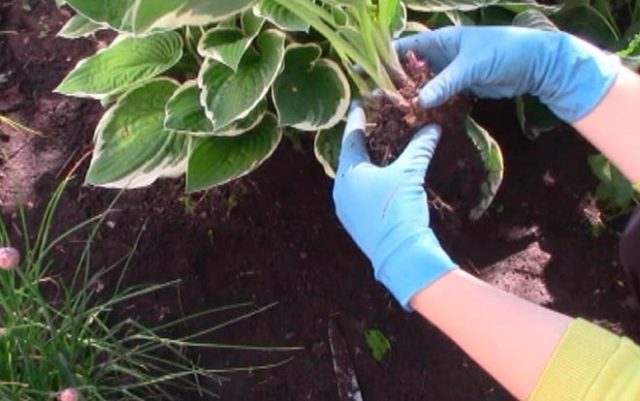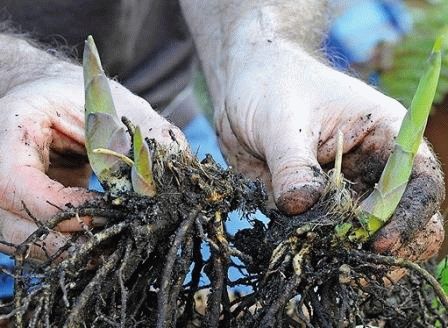Content
Many gardeners prefer to divide the hosta bush in the spring. Then the cuttings transplanted to a new place have time to adapt and produce young shoots. At the same time, the mother bush can be propagated in the fall. It is better to do this a month before the first frost.
Features of hosta propagation by dividing the bush
Dividing a bush is considered the simplest way to propagate plants, which does not require, for example, growing cuttings or layering or special care for them. However, this also has its own subtleties: the main rule is to do everything carefully so as not to damage the mother bush. Therefore, it is recommended to pay attention to a few tips from experienced gardeners:
- It is best to divide a hosta bush when the plant is already quite mature. The shrub must be at least 3-4 years old. You can navigate by 2 main signs - the bush has become spreading, lush, the main thing is that the crown has stopped actively growing, it seems to have begun to shrink.
- You should not often divide the same bush. This is a stressful situation that the host should not be subjected to often. Therefore, an interval of 2-3 years should be observed, otherwise the bush will not grow well.
- The most important thing in the process of propagating hostas by dividing the bush is precision and accuracy of movements. The bush will inevitably be injured, but if everything is done carefully, the damage will be minimal. To do this, you should also use garden tools - for example, for a small bush, a knife with teeth is suitable, and for a larger plant, a hacksaw.
- Since separation creates wounds, they should be immediately sprinkled with wood ash. The instruments themselves also need to be disinfected. To do this, you can use any alcohol-containing composition or a weak solution of potassium permanganate with a concentration of 1-2%.

You need to divide the bush carefully, after untangling the young roots
When is the best time to divide a hosta: in spring or autumn?
Many gardeners agree that it is best to divide the hosta in the spring or summer, so that by the fall the new bushes have time to take root. However, if the deadline has already passed, you can start dividing the bush even in September. It is necessary to have time to meet the warm period in such a way that frosts occur only in a month.
In addition, it is convenient to divide the hosta in the fall, because the plant is already entering a quiet period - metabolic processes are suspended, juices do not move so actively in the tissues. Therefore, at such a moment the least harm will be done to the host.
When can hosta be divided and planted in the spring?
In spring, the optimal period is considered to be the beginning of May. It is important that there is no longer any threat of return frosts. Therefore, in Siberia and the Urals, dividing a hosta bush sometimes has to be done only in the summer or early autumn.
Is it possible to divide the hosta in the summer?
In summer you can choose any period - June, July, August. The sooner you start dividing the bush, the faster it takes root in the new place. If you perform this procedure in hot weather, the hosta will require additional watering.
When to plant a hosta by dividing the bush in the fall
It is advisable to divide the hosta in the fall in the first half of September. It is important to calculate the time so that there are at least 3-4 weeks left before the first frost. Therefore, the timing of dividing the bush depends on the specific region:
- In Siberia and the Urals - the end of August or the very beginning of September.
- In the middle zone - mid-September.
- In the southern regions - late September or early October.

You can divide the bush at any warm time of the year, but at least a month before frost
How to properly divide a hosta
Propagating hosta by dividing the bush is quite simple. There are 2 options:
- Small hostas are dug up or cut out at a distance of 10 cm from the center (that is, move 10 cm away from the main shoot).
- A larger hosta is dug up by marking a circle with a radius of 35 cm from the center.
There is no need to dig up the ground first - on the contrary, it is better not to disturb the soil so that it remains dense. If the shovel is old, it is better to sharpen it further.
Site selection and soil preparation
In order for the divisions to feel as comfortable as possible, they should be planted at the same depth as the mother bush. When choosing a location, pay attention to several points:
- most hostas like weak or even strong shade;
- it is better to place them in places protected from strong winds;
- It is preferable to choose small hills rather than lowlands in which melt water and precipitation accumulate.
The composition of the soil can be any, always with humus or compost. Moreover, there is no need to give fertilizers right away - they are usually applied for the next season. The soil does not require special preparation, since the hosta is an unpretentious plant. It takes root even on dry sandy and heavy clay soils.
How to dig up and divide hosta bushes
It is optimal to separate in cloudy weather. If the day is sunny, it is better to start the procedure in the evening. The instructions are as follows:
- Along the perimeter of the tree trunk circle (diameter from 10 to 35 cm), the soil is cut using a sharp shovel.
- You need to go about 1 bayonet deep, moving closer to the center all the time, so that you end up with a layer of earth along with the roots.
- When the soil is completely cut, take the bush and hit the surface several times so that the excess soil falls off.
- If there is a lot of soil left on the surface, it is better to wash it off with water pressure. Thanks to this, you can see the peculiarities of the structure of the roots and divide the bush as carefully as possible.
- Next, carefully untangle the roots and divide them into several parts, cutting them with a knife. In this case, the movement should go towards and away from you, and not to the sides - otherwise the roots may crumble.
- If you plan to divide it only into 2 parts and get 1 small shoot, you can cut it off with a shovel from the side without injuring the entire root.

It is convenient to cut small rhizomes with a sharp knife, filing them with light movements
Planting divided bushes
To plant hostas in a different place in the fall after dividing the bush, you will need:
- humus;
- garden soil;
- garden knife;
- sharp shovel;
- mulch - hay, sawdust or peat;
- 2-3 buckets of water.
The landing instructions are as follows:
- Dig several holes at a distance of 40-50 cm - depending on the characteristics of the variety (it is better to prepare them 2 weeks in advance). Their depth is small - up to 30 cm.
- Fill with a mixture of garden soil and humus.
- Root the cuttings and sprinkle them with soil.
If propagation is carried out in the spring, it is better to leave all the leaves so that the hosta continues to grow confidently.

The divisions can be planted next to the mother plant and transplanted to a permanent place the next season.
How to divide a hosta bush without digging
You can propagate the hosta by dividing the bush without even digging it up completely. Thanks to this, he is injured to a lesser extent. The instructions are as follows:
- Take a sharp shovel and dig only from one side.
- Using a knife, separate one small part. It is first cut off from the plant itself.
- Then an acute angle is formed (towards you) - the result is a triangle.
- Then the resulting void in the ground is filled with soil mixed with humus.
- It is not necessary to cover the cut with ash, since it will not come into contact with air. But after the procedure, the plant needs to be watered well.
Plant care
Further care is quite simple:
- Immediately after transplantation, water well (a bucket per plant).
- Mulch with sawdust, peat or hay.
- If propagation of hostas by dividing the bush is carried out in the fall, it is useful to hill up the plants and put a large layer of mulch (in the south you don’t have to do this, but for other regions it is important).
It is not necessary to fertilize, since humus has already been added to the hole. In addition, this plant does not require constant feeding. If the bush was propagated in the fall, there is no need to add fertilizer: the last time it is applied is only at the end of August. And in September, metabolic processes in tissues slow down - the plant is preparing for a dormant period.
Conclusion
Dividing the hosta bush in the spring can be done as early as May, when the threat of return frosts will be minimized. In some cases, it is not even necessary to dig up the bush. For work use a sharp shovel and knife.








